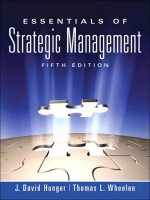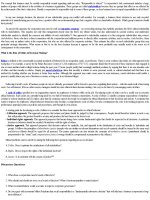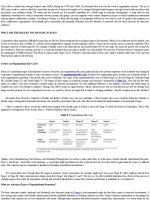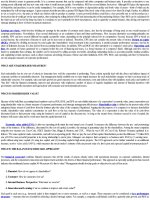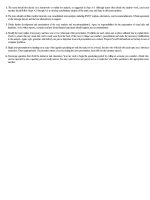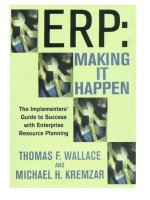Essentials of Strategic Management 5th Edition_8 docx
Bạn đang xem bản rút gọn của tài liệu. Xem và tải ngay bản đầy đủ của tài liệu tại đây (563.07 KB, 18 trang )
uses the division’s assets to generate profits. It is a common measure that can be compared with other companies and business units. It provides an incentive to use
existing assets efficiently and buy new ones only when it would increase profits. Nevertheless, ROI has several distinct limitations. Although ROI gives the impression
of objectivity and precision, it can be easily manipulated. For example, ROI is very sensitive to depreciation policy and book value of assets—both of which can be
manipulated by self-serving managers. A given amount of profits provides a greater ROI figure if the book value of the assets is low than if it is high. Further, it is difficult
to set a transfer price, the price at which one division sells its product to another. A more powerful division could force a less powerful one to sell its product at a
lower price than it would get on the open market, thus reducing the selling division’s ROI and increasing that of the purchasing division. Since ROI can be calculated for
the short run as well as for the long run, there is a tendency to use it primarily for short-run purposes, such as quarterly or annual bonuses, thus driving out long-term
strategic planning in favor of short-run tactical maneuvers.
Earnings per share, which involves dividing net earnings by the number of common stock shares, also has the advantage of being used as one overall measure of
corporate performance. Nevertheless, it has several deficiencies as an evaluation of past and future performance. First, because alternative accounting principles are
available, EPS can have several different but equally acceptable values, depending on the principle selected for its computation. Second, because EPS is based on
accrual income, the conversion of income to cash can be near term or delayed. Therefore, EPS does not consider the present value of money. Return on equity
(ROE), obtained by dividing net income by total equity (the shareholders’ total investment in the corporation), is another popular performance measure, but has its
share of limitations because it is also derived from accounting-based data. In addition, EPS and ROE are often unrelated to a company’s stock price. Operating cash
flow, the amount of money generated by a company before the cost of financing and taxes, is a broad measure of a company’s funds. Although cash flow may be
harder to manipulate than earnings, the number can be increased by selling accounts receivable, classifying outstanding checks as accounts payable, trading securities,
and capitalizing certain expenses, such as direct-response advertising. Because of these and other limitations, ROI, EPS, ROE, and operating cash flow by themselves
are not adequate measures of corporate performance.
WHAT ARE STAKEHOLDER MEASURES?
Each stakeholder has its own set of criteria to determine how well the corporation is performing. These criteria typically deal with the direct and indirect impact of
corporate activities on stakeholder interests. Top management should establish one or more simple measures for each stakeholder category so that it can keep track of
stakeholder concerns. For example, sales and sales growth are good measures to use with customers; costs and delivery time with suppliers; stock price and number of
“buy lists” with the financial community; turnover and grievances with employees; number of pieces of negative legislation and amount of financial incentives with
government; and hostile encounters and legal actions with consumer and environmental advocates.
WHAT IS SHAREHOLDER VALUE?
Because of the belief that accounting-based numbers such as ROI, ROE, and EPS are not reliable indicators of a corporation’s economic value, many corporations are
using shareholder value as a better measure of corporate performance and strategic management effectiveness. Shareholder value is defined as the present value of the
anticipated future stream of cash flows from the business plus the value of the company if liquidated. Arguing that the purpose of a company is to increase shareholder
wealth, shareholder value analysis concentrates on cash flow as the key measure of performance. The value of a corporation is thus the value of its cash flows
discounted back to their present value, using the business’s cost of capital as the discount rate. As long as the returns from a business exceed its cost of capital, the
business will create value and be worth more than the capital invested in it.
Economic value added (EVA) is after-tax operating profit minus the total annual cost of capital. It measures the difference between the pre- and poststrategy
value of the business. If the difference, discounted by the cost of capital, is positive, the strategy is generating value for the shareholders. Among the many companies
using the new measure are Coca-Cola, AT&T, Quaker Oats, Briggs & Stratton, and CSX. , When he was CEO of Coca-Cola, Roberto Goizueta explained it as
follows: “We raise capital to make concentrate, and sell it at an operating profit. Then we pay the cost of that capital. Shareholders pocket the difference.”
3
Unlike ROI,
one of EVA’s most powerful properties is its strong relationship to stock price. Managers can improve their company’s or business unit’s EVA by (1) earning more
profit without using more capital, (2) using less capital, and (3) investing capital in high-return projects. The EVA approach can be further extended to an additional
measure, market value added (MVA), which measures the stock market’s estimate of the net present value of a firm’s past and expected capital investment projects.
4
WHAT IS THE BALANCED SCORECARD APPROACH?
The balanced scorecard combines financial measures that tell the results of actions already taken with operational measures on customer satisfaction, internal
processes, and the corporation’s innovation and improvement activities: the drivers of future financial performance. This approach is especially useful given that research
indicates that nonfinancial assets explain 50-80 percent of a firm’s value.
5
Management should develop goals or objectives in each of four areas:
1. Financial: How do we appear to shareholders?
2. Customer: How do customers view us?
3. Internal Business Perspective: What must we excel at?
4. Innovation and Learning: Can we continue to improve and create value?
6
Each goal in each area (e.g., increased sales) is then assigned one or more measures, as well as a target. These measures can be considered as key performance
measures —measures that are essential for achieving a desired strategic option. For example, a company could include cash flow, quarterly sales growth, and ROE as
measures for success in the financial area; market share (competitive position goal) and percentage of new sales coming from new products (customer acceptance goal)
as measures under the customer perspective; cycle time and unit cost (manufacturing excellence goal) as measures under the internal business perspective; and time to
develop next-generation products (technology leadership objective) under the innovation and learning perspective. The balanced scorecard is used by over half of the
Fortune Global 1000 companies.
7
HOW IS TOP MANAGEMENT EVALUATED?
Through its strategy, audit, and compensation committees, a board of directors closely evaluates the job performance of the CEO and the top management team. The
vast majority of American, European, and Asian boards review the CEO’s performance using a formalized process. The board is concerned primarily with overall
profitability as measured quantitatively by ROI, ROE, EPS, and shareholder value. The absence of short-run profitability is certainly a factor contributing to the firing of
any CEO, but the board is also concerned with other factors.
Members of the compensation committees of today’s boards of directors generally agree that measuring a CEO’s ability to establish strategic direction, build a
management team, and provide leadership is more critical in the long run than are a few quantitative measures. The board should evaluate top management not only on
the typical output-oriented quantitative measures, but also on behavioral measures—factors relating to its strategic management practices. Performance evaluations of
the overall board’s performance are also standard practice;
8
evaluations of individual directors are less common.
What Are the Primary Measures of Divisional and Functional Performance?
Companies use a variety of techniques to evaluate and control performance in divisions, strategic business units (SBUs), and functional areas. If a corporation is
composed of SBUs or divisions, it will use many of the same performance measures (ROI or EVA, for instance) that it uses to assess overall corporation performance.
To the extent that it can isolate specific functional units, such as R&D, the corporation may develop responsibility centers. It will also use typical functional measures
such as market share and sales per employee (marketing), unit costs and percentage of defects (operations), percentage of sales from new products and number of
patents (R&D), and turnover and job satisfaction (HRM).
During strategy formulation and implementation, top management approves a series of programs and supporting operating budgets from its business units.
Operating budgets list the costs and expenses for each proposed program in dollar terms. During evaluation and control, management contrasts actual expenses with
planned expenditures and assesses the degree of variance, typically on a monthly basis. In addition, top management probably will require periodic statistical reports,
which summarize data on key factors, such as the number of new customer contracts, volume of received orders, and productivity figures.
WHAT ARE RESPONSIBILITY CENTERS?
Control systems can be established to monitor specific functions, projects, or divisions. For example, budgets are typically used to control the financial indicators of
performance. Responsibility centers are used to isolate a unit so that it can be evaluated separately from the rest of the corporation. A responsibility center has its
own budget, is evaluated on its use of budgeted resources, and is headed by a manager who is responsible for its performance. The center uses resources (measured in
terms of costs or expenses) to produce a service or a product (measured in terms of volume or revenues). The way in which the corporation’s control system measures
these resources and services or products determines which of the five major types of responsibility centers is used.
• Standard cost centers. Primarily used in manufacturing facilities, standard (or expected) costs are computed for each operation on the basis of historical data. In
evaluating the center’s performance, its total standard costs are multiplied by the units produced; the result is the expected cost of production, which is then
compared to the actual cost of production.
• Revenue centers. Production, usually in terms of unit or dollar sales, is measured without considering resource costs (e.g., salaries). The center is thus judged in
terms of effectiveness rather than efficiency. The effectiveness of a sales region, for example, is determined by comparing its actual sales to its projected or
previous year’s sales. Profits are not considered because sales departments have limited influence over the cost of the products they sell.
• Expense centers. Resources are measured in dollars without considering service or product costs. Thus budgets are prepared for engineered expenses (costs
that can be calculated) and for discretionary expenses (costs that can be only estimated). Typical expense centers are administrative, service, and research
departments. They cost money, but contribute only indirectly to revenues.
• Profit centers. Performance is measured in terms of the difference between revenues (which measure production) and expenditures (which measure resources).
A profit center is typically established whenever an organizational unit controls both its resources and its products or services. By having such centers, a
company can be organized into divisions of separate product lines.
• Investment centers. Because many divisions in large manufacturing corporations use significant assets to make their products, their asset base should be
factored into their performance evaluation. Thus to focus only on profits, as in the case of profit centers, is insufficient. An investment center’s performance is
measured in terms of the difference between its resources and its services or products. The most widely used measure of investment center performance is ROI.
Most single-business corporations, such as Apple, tend to use a combination of cost, expense, and revenue centers. In these corporations, most managers are functional
specialists who manage against a budget. Total profitability is integrated at the corporate level. Multidivisional corporations with one dominating product line, such as
Anheuser-Busch, which have diversified into a few small businesses but which still depend on a single product line (e.g., beer) for most of their revenue and income,
generally use a combination of cost, expense, revenue, and profit centers. Multidivisional corporations, such as General Electric, tend to emphasize investment centers,
although various units throughout the corporation use other types of responsibility centers. One problem with using responsibility centers, however, is that the separation
needed to measure and evaluate a division’s performance can make it difficult to achieve the level of cooperation among divisions needed to attain synergy for the
corporation as a whole.
HOW IS BENCHMARKING USED TO EVALUATE PERFORMANCE?
According to Xerox Corporation, the company that pioneered this concept in the United States, benchmarking is the continual process of measuring products, services,
and practices against the toughest competitors or those companies recognized as industry leaders. Benchmarking involves openly learning how other companies do
something better and not only imitating, but perhaps even improving on their techniques. The benchmarking process usually involves the following steps:
1. Identify the area or process to be examined: It should be an activity which has the potential to determine a business unit’s competitive advantage.
2. Find behavioral and output measures of the area or process and obtain measurements.
3. Select an accessible set of competitors and best-in-class companies against which to benchmark: These may very often be companies that are in completely
different industries but perform similar activities. For example, when Xerox wanted to improve its order fulfillment, it went to L. L. Bean, the successful mail
order firm, to learn how it achieved excellence in this area.
4. Calculate the differences among the company’s performance measurements and those of the best-in-class: Determine why the differences exist.
5. Develop programs for closing performance gaps.
6. Implement the programs and then compare the resulting new measurements with those of the best-in-class companies.
A recent survey of 1,430 international executives indicated that benchmarking was used by 76 percent of the companies—the most widely used management
tool.
9
Cost reductions range from 15 to 45 percent.
10
Benchmarking can also increase sales, improve goal setting, and boost employee motivation.
11
APQC (American
Productivity & Quality Center), a Houston research group, established the Open Standards Benchmarking Collaborative database, composed of more than 1,200
commonly used measures and individual benchmarks (see ).
What Are International Measurement Issues?
The three most widely used techniques for international performance evaluation are ROI, budget analysis, and historical comparisons. Even though ROI is the single
most used measure of international operations, it has serious limitations. Because of foreign currencies, different rates of inflation, different tax laws, and the use of
transfer pricing, both the net income figure and the investment base may be seriously distorted. Transfer pricing is used heavily in MNCs not only to calculate the ROI
for responsibility centers in various countries, but also to minimize taxes. For example, parts made in a subsidiary of an MNC in a low-tax country like Singapore can be
shipped to its subsidiary in a high-tax country like the United States at such a high price that the U.S. subsidiary reports very little profit (and thus pays few taxes), while
the Singapore subsidiary reports a very high profit (but also pays few taxes because of the lower tax rate). The MNC can, therefore, earn more profit worldwide by
reporting less profit in high-tax countries and more profit in low-tax ones (assuming governments in high-tax countries do not retaliate with tariff barriers and lawsuits).
The control and reward systems used by a global MNC are usually different from those used by a multidomestic MNC. The multidomestic MNC uses loose
controls on its foreign units. The management of each geographic unit is given considerable operational latitude, but is expected to meet some performance targets.
Multiple measures are used to differentiate between the worth of the subsidiary and the performance of its management. The global MNC, in contrast, needs tight
controls over its many units. To reduce costs and gain competitive advantage, it spreads the manufacturing and marketing operations of a few fairly uniform products
around the world. Therefore, its key operational decisions are centralized. Foreign units are thus evaluated more as cost, revenue, or expense centers than as investment
or profit centers because MNCs operating in a global industry do not often make the entire product in the country in which it is sold.
10.3 STRATEGIC INFORMATION SYSTEMS
Before performance measures can have any impact on strategic management, they must first be communicated to the people responsible for formulating and
implementing strategic plans. Strategic information systems, whether computer based or manual, formal or informal, can perform this function. One of the key reasons
for the success of Wal-Mart has been management’s use of the company’s sophisticated information system to control purchasing decisions. Cash registers in Wal-Mart
retail stores transmit information hourly to computers at company headquarters. Consequently managers know every morning exactly how many of each item have been
sold the day before, how many have been sold so far in the year, and how this year’s sales compare to last year’s. The information system allows all reordering to be
done automatically by computers without any managerial input. It also allows the company to experiment with new toys without committing to big orders in advance. In
effect, the system allows the customers to decide through their purchases what gets reordered.
Many corporations around the world are adopting enterprise resource planning (ERP) software. ERP unites all of a company’s major business activities from
order processing to production within a single family of software modules. The system provides instant access to critical information to everyone in the organization from
the CEO to the factory floor worker. Because of the ability of ERP software to use a common information system throughout a company’s many operations around the
world, it is becoming the business information systems’ global standard. Nevertheless, the system is extremely complicated and demands a high level of standardization
throughout a corporation. The major providers of this software are SAP, Oracle, J. D. Edwards, Baan, and SSA.
At the divisional or SBU level of a corporation, the information system should be used to support, reinforce, or enlarge its business-level strategy through its
decision support system. An SBU pursuing a strategy of overall cost leadership could use its information system to reduce costs either by improving labor productivity
or by improving the use of other resources such as inventory or machinery. For example, Radio frequency identification (RFID) is an electronic tagging technology
used in a number of companies to improve supply-chain efficiency. By tagging containers and items with tiny chips, companies use the tags as wireless bar codes to
track inventory more efficiently.
10.4 GUIDELINES FOR PROPER CONTROL
Measuring performance is a crucial part of evaluation and control. The lack of quantifiable objectives or performance standards and the inability of the information
system to provide timely, valid information are two obvious control problems. Without objective and timely measurements, making operational, let alone strategic,
decisions would be extremely difficult. Nevertheless, the use of timely, quantifiable standards does not guarantee good performance. The very act of monitoring and
measuring performance can cause side effects that interfere with overall corporate performance. Inappropriate controls can result in managers manipulating the measures
for personal advantage to the detriment of the company.
In designing a control system, top management should remember that controls should follow strategy. Unless controls ensure the use of the proper strategy to
achieve objectives, dysfunctional side effects are likely to completely undermine the implementation of the objectives. The following guidelines are recommended:
1. Controls should involve only the minimum amount of information needed to give a reliable picture of events. Too many controls create confusion.
Focus on the strategic factors by following the 80/20 rule: Monitor those 20 percent of the factors that determine 80 percent of the results.
2. Controls should monitor only meaningful activities and results. Regardless of measurement difficulty, if cooperation between divisions is important to
corporate performance, some form of qualitative or quantitative measure should be established to monitor cooperation.
3. Controls should be timely. Corrective action must be taken before it is too late. Steering controls, that is, controls that monitor or measure the factors
influencing performance, should be stressed so that advance notice of problems is given.
4. Controls should be long term and short term. If only short-term measures are emphasized, a short-term managerial orientation is likely.
5. Controls should pinpoint exceptions. Only those activities or results that fall outside a predetermined tolerance range should call for action.
6. Controls should be used to reward meeting or exceeding standards rather than to punish failure to meet standards. Heavy punishment of failure
typically results in goal displacement. Managers will “fudge” reports and lobby for lower standards.
To the extent that the corporate culture complements and reinforces the strategic orientation of the firm, there is less need for an extensive formal control system.
10.5 STRATEGIC INCENTIVE MANAGEMENT
To ensure congruence between the needs of the corporation as a whole and the needs of the employees as individuals, management and the board of directors should
develop an incentive program that rewards desired performance. Incentive plans should be linked in some way to corporate and divisional strategy. Research does
reveal that firm performance is affected by its compensation policies. Companies using different business strategies tend to adopt different pay policies. For example, a
survey of 600 business units indicates that the pay mix associated with a growth strategy emphasizes bonuses and other incentives over salary and benefits, whereas the
pay mix associated with a stability strategy has the reverse emphasis.
12
The following three approaches are tailored to help match measurements and rewards with explicit strategic objectives and time frames:
13
• Weighted-factor method. This method is particularly appropriate for measuring and rewarding the performance of top SBU managers and group-level
executives when performance factors and their importance vary from one SBU to another. The measurements that one corporation uses might contain the
following variations: The performance of high-growth SBUs is measured in terms of market share, sales growth, designated future payoff, and progress on
several future-oriented strategic projects; the performance of low-growth SBUs, in contrast, is measured in terms of ROI and cash generation; and the
performance of medium-growth SBUs is measured with a combination of these factors (see Table 10.1).
• Long-term evaluation method. This method compensates managers for achieving objectives set over a multiyear period. An executive is promised some
company stock or “performance units” (convertible into money) in amounts to be based on long-term performance. An executive committee, for example, might
set a particular objective in terms of growth in EPS during a five-year period. Awards would be contingent on the corporation’s meeting that objective within the
designated time. Any executive who leaves the corporation before the objective is met receives nothing. The typical emphasis on stock price makes this
approach more applicable to top management than to business unit managers.
Table 10.1 Weighted-Factor Approach to Strategic Incentive Management
Table 10.2 Strategic-Funds Approach to an SBU’s Profit and Loss Statement
• Strategic-funds method. This method encourages executives to look at developmental expenses as being different from those expenses required for current
operations. The accounting statement for a corporate unit enters strategic funds as a separate entry below the current ROI. It is therefore possible to distinguish
between those expense dollars consumed in the generation of current revenues and those invested in the future of the business. Therefore, the manager can be
evaluated on both a short- and a long-term basis and has an incentive to invest strategic funds in the future (see Table 10.2).
An effective way to achieve the desired strategic results through a reward system is to combine the three approaches in the following manner:
1. Segregate strategic funds from short-term funds, as is done in the strategic-funds method.
2. Develop a weighted-factor chart for each SBU.
3. Measure performance on three bases: the pretax profit indicated by the strategic-funds approach, the weighted factors, and the long-term evaluation of SBU
and corporate performance.
Discussion Questions
1. Is Figure 10.1 a realistic model of the evaluation and control process?
2. What are some examples of behavior, output, and input controls?
3. Is EVA really an improvement over ROI, ROE, or EPS?
4. How much faith can a manager place in a transfer price as a substitute for a market price in measuring a profit center’s performance?
5. Is the evaluation and control process appropriate for a corporation that emphasizes creativity? Are control and creativity compatible?
Key Terms (listed in order of appearance)
behavior controls 149
output controls 149
input controls 149
activity-based costing 150
return on investment 150
earnings per share 151
return on equity 151
operating cash flow 151
shareholder value 152
economic value added 152
balanced scorecard 152
key performance measures 152
responsibility center 154
benchmarking 155
80/20 rule 157
weighted-factor method 158
long-term evaluation method 158
strategic-funds method 159
Notes
1. K. F. Iverson with T. Varian, “Plain Talk,” Inc. (October 1997), p. 81. Excerpted from Iverson’s book, Plain Talk: Lessons from a Business Maverick,
published by John Wiley, 1997.
2. T. R. V. Davis and B. L. Darling, “ABC in a Virtual Corporation,” Management Accounting (October 1996), pp. 18–26.
3. S. Tully, “The Real Key to Creating Wealth,” Fortune (September 20, 1993), p. 38.
4. A. B. Fisher, “Creating Stockholder Wealth: Market Value Added,” Fortune (December 11, 1995), pp. 105–116.
5. D. I. Goldenberg, “Shareholder Value Debunked,” Strategy & Leadership (January/February 2000), p. 34.
6. R. S. Kaplan and D. P. Norton, “Using the Balanced Scorecard as a Strategic Management System,” Harvard Business Review (January–February 1996),
pp. 75–85; R. S. Kaplan and D. P. Norton, “The Balanced Scorecard—Measures That Drive Performance,” Harvard Business Review (January–February,
1992), pp. 71–79.
7. P. D. Heaney, “Can Performance Be Measured?”Progressive Grocer, Vol. 82 (2003), pp. 11–13.
8. S. P. Mader, D. Vuchot, and S. Fukushima of Korn/Ferry International, 33rd Annual Board of Directors Study (2006), p. 9.
9. Management Tools and Trends 2009, Bain & Company, www.bain.com.
10. R. J. Kennedy, “Benchmarking and Its Myths,” Competitive Intelligence Magazine (April–June 2000), pp. 28–33.
11. L. Mann, D. Samson, and D. Dow, “A Field Experiment on the Effects of Benchmarking & Goal Setting on Company Sales Performance,” Journal of
Management, Vol. 24, No. 1 (1998), pp. 73–96.
12. D. B. Balkin and L. R. Gomez-Mejia, “Matching Compensation and Organizational Strategies,” Strategic Management Journal (February 1990), pp. 153–
169.
13. P. J. Stonich, “The Performance Measurement and Reward System: Critical to Strategic Management,” Organizational Dynamics (Winter 1984), pp. 45–
57.
11 SUGGESTIONS FOR CASE ANALYSIS
An analysis of a corporation’s strategic management calls for a comprehensive view of the organization. The case method of analysis provides the opportunity to move
from a narrow, specialized view that emphasizes technical skills to a broader, less precise analysis of the overall corporation that emphasizes conceptual skills.
11.1 THE CASE METHOD
The analysis and discussion of case problems has been the most popular method of teaching strategy for many years. Cases present actual business situations and
enable you to examine both successful and unsuccessful corporations. In case analysis, you might be asked to critically analyze a situation in which a manager had to
make a decision of long-term corporate importance. This approach gives you a feel for what it is like to be faced with making and implementing strategic decisions.
11.2 FRAMEWORKS FOR CASE ANALYSIS
There is no one best way to analyze or present a case report. Each instructor has personal preferences for format and approach. Nevertheless, we suggest an approach
for both written and oral reports in Appendix 11.A, which provides a systematic method for successfully dealing with a case.
Case discussion focuses on critical analysis and logical development of thought. A solution is satisfactory if it resolves important problems and is likely to be
implemented successfully. How the corporation actually dealt with the case problems has no real bearing on the analysis because management might have analyzed its
problems incorrectly or implemented a series of flawed solutions.
The presentation of a case analysis can be organized on the basis of several frameworks: One framework is SWOT analysis, followed by a discussion of strategic
alternatives and a recommendation; another is the strategic audit as discussed in Appendix 11.C. Regardless of the framework chosen, be careful to include a complete
analysis of key environmental variables, especially industry trends, the competition, and international developments.
11.3 RESEARCHING THE CASE SITUATION
Depending on your instructor, you should undertake outside research into the environmental setting of the case. Find out the date when the case situation occurred and
then screen the business periodicals for that time period. An understanding of the economy during that period will help you avoid making a serious error in your analysis;
for example, suggesting a sale of stock when the stock market is at an all-time low or taking on more debt when the prime interest rate is over 15 percent. Information
on the industry will provide insights on its competitive activities. This background will give you an appreciation for the situation as the participants in the case experienced
it. In the United States, a company’s 10-K (annual report), 10-Q (quarterly report), and 14-A (proxy statement) reports from the year of the case can be very helpful.
These reports can usually be found at the corporation’s Web site or at the U.S. Securities and Exchange Commission (www.sec.gov). Some resources available for
research into the economy and a corporation’s industry are suggested in Appendix 11.B.
Important Note: Before obtaining additional information about the company profiled in a particular case, ask your instructor if this is appropriate for your class
assignment. Your strategy instructor may want you to stay within the confines of the case information provided in the book. In this case, it is usually acceptable to at
least learn more about the natural and societal environments at the time of the case.
11.4 FINANCIAL ANALYSIS: A PLACE TO BEGIN
Ratio analysis is the calculation of ratios from data in a company’s financial statements. It is done to identify possible financial strengths or weaknesses; thus, it is a
valuable part of SWOT analysis. A review of key financial ratios can help you assess the company’s overall situation and pinpoint some problem areas. Ratios control
for firm size and enable you to compare a company’s ratios with industry averages. Table 11.1 lists some of the most important financial ratios: (1) liquidity ratios, (2)
profitability ratios, (3) activity ratios, and (4) leverage ratios.
How are Financial Statements Analyzed?
Calculate all relevant ratios and discuss those ratios that have an impact on the company’s problems. Compare these ratios with industry averages to discover whether
the company is out of line with others in the industry. If industry averages are not available, use those of a successful competitor. A typical financial analysis of a firm
would include a study of the operating statements for five or so years, including a trend analysis of sales, profits, earnings per share, debt to equity ratio, and return on
investment, plus a ratio analysis comparing the firm under study with industry standards. As a minimum, undertake the following five steps in basic financial analysis:
1. Scrutinize historical income statements and balance sheets. These two basic statements provide most of the data needed for analysis. Statements of cash
flow may also be useful.
2. Compare historical statements over time if a series of statements is available.
3. Calculate changes that occur in individual categories from year to year, as well as the cumulative total change.
4. Determine the change as a percentage as well as an absolute amount.
5. Adjust for inflation if that was a significant factor.
Table 11.1 Financial Ratio Analysis
Examination of this information may reveal developing trends. Compare trends in one category with those in related categories. For example, an increase in sales of 15
percent over three years may appear to be satisfactory until you note an increase of 20 percent in the cost of goods sold during the same period. The outcome of this
comparison might suggest that further investigation into the manufacturing process is necessary. If a company is reporting strong net income growth but negative cash
flow, this would suggest that the company is relying on something other than operations for earnings growth. Is it selling off assets or cutting R&D? If accounts
receivable are growing faster than sales revenues, the company is not getting paid for the products or services it is counting as sold.
What are Common-Size Statements?
Common-size statements are income statements and balance sheets in which the dollar figures have been converted into percentages. For the income statement, net
sales represent 100 percent: Calculate the percentage of each category so that the categories sum to the net sales percentage (100%). For the balance sheet, give the
total assets a value of 100 percent and calculate other asset and liability categories as percentages of the total assets. (Individual asset and liability items, such as
accounts receivable and accounts payable, can also be calculated as a percentage of net sales.)
When you convert statements to this form, it is relatively easy to note the percentage that each category represents of the total. Look for trends in specific items,
such as cost of goods sold, when compared to the company’s historical figures. To get a proper picture, however, compare these data with industry data. If a firm’s
trends are generally in line with those of the rest of the industry, the likelihood of problems is less than if they are worse than industry averages. These statements are
especially helpful in developing scenarios and pro forma statements because they provide a series of historical relationships (e.g., cost of goods sold to sales, interest to
sales, and inventories as a percentage of assets).
What Other Financial Calculations are Useful in Analysis?
If the corporation being studied appears to be in poor financial condition, use Altman’s Bankruptcy Formula to calculate its Z-value. The Z-value indicates how close
a company is to bankruptcy. It combines five ratios by weighting them according to their importance to a corporation’s financial strength. The formula is:
Z = 1.2 x
1
+ 1.4 x
2
+ 3.3 x
3
+ 0.6 x
4
+ 1.0 x
5
where:
x1 = Working capital/Total assets (%)
x
2
= Retained earnings/Total assets (%)
x
3
= Earnings before interest and taxes/Total assets (%)
x
4
= Market value of equity/Total liabilities (%)
x
5
= Sales/Total assets (number of times)
Scores below 1.81 indicate significant credit problems, whereas scores above 3.0 indicate a healthy firm. Scores between 1.81 and 3.0 indicate question marks.
1
The index of sustainable growth is useful to learn if a company embarking on a growth strategy will need to take on debt to fund this growth. The index indicates
how much of the growth rate of sales can be sustained by internally generated funds. The formula is:
where:
P = (Net profit before tax/Net sales) x 100
D = Target dividends/Profit after tax
L = Total liabilities/Net worth
T = (Total assets/Net sales) x 100
If the planned growth rate calls for a growth rate higher than its g*, external capital will be needed to fund the growth unless management is able to find efficiencies,
decrease dividends, increase the debt to equity ratio, or reduce assets by renting or leasing arrangements.
2
How Should Inflation, Interest Rates, and GDP be Used?
If you are analyzing a company over many years, you may want to adjust sales and net income for inflation to arrive at “true” financial performance in constant dollars.
Constant dollars are dollars adjusted for inflation to make them comparable over various years. In the United States, the consumer price index (CPI) is an easy way
to adjust for inflation (see Table 11.2). Dividing sales and net income by the CPI factor for that year changes the figures to 1982-1984 constant dollars.
Table 11.2 U.S. Economic Indicators: Gross Domestic Product (GDP); Consumer Price Index (CPI) for All Items (1982–1984 = 1.0); Prime Interest Rate
(PIR)
Another helpful analytical aid is prime interest rate (PIR) —;the rate of interest banks charge on their lowest risk loans. To better assess strategic decisions, note
the level of the PIR at the time of the case (see Table 11.2). A decision to borrow money to build a new plant would have been very costly in 2000, but inexpensive in
2003.
In preparing a scenario for your pro forma financial statements, you may want to use the gross domestic product (GDP) from Table 11.2. The GDP is used
worldwide and measures the total output of goods and services within a country’s borders. It is a good indicator of a country’s overall economic health.
11.5 USING THE STRATEGIC AUDIT IN CASE ANALYSIS
Appendix 11.C is an example of a strategic audit proposed for use not only in strategic decision making, but also as a framework for the analysis of complex strategy
cases. The questions in the audit parallel the eight steps depicted in Figure 1.3, the strategic decision-making process. The strategic audit provides a checklist of
questions, by area or issue that enables a person to make a systematic analysis of various corporate activities. It is extremely useful as a diagnostic tool to pinpoint
problem areas and to highlight strengths and weaknesses. It is not an all-inclusive list, but it presents many of the critical questions that need to be addressed in the
strategic analysis of any business corporation. Some questions or even some areas might be inappropriate for a particular case; in other cases, the questions may be
insufficient for a complete analysis. However, each question in a particular area of the strategic audit can be broken down into an additional series of subquestions.
Develop these subquestions as they are needed.
Discussion Questions
1. Why should you begin a case analysis with a financial analysis? When are other approaches appropriate?
2. What are common-size financial statements? What is their value to case analysis? How are they calculated?
3. When should you gather information outside a case by going to the library or using the Internet? What should you look for?
4. When is inflation an important issue in conducting case analysis?
5. How can you learn what date a case took place?
Key Terms (listed in order of appearance)
ratio analysis 162
common-size statements 166
Z-value 166
index of sustainable growth 166
constant dollars 167
strategic audit 168
Notes
1. M. S. Fridson, Financial Statement Analysis (New York: John Wiley & Sons, 1991), pp. 192–194.
2. D. H. Bangs, Managing by the Numbers (Dover, N.H.: Upstart Publications, 1992), pp. 106–107.
Suggested Techniques for Case Analysis and Presentation
A. CASE ANALYSIS
1. Read the case to get an overview of the nature of the corporation and its environment. Note the date in which the case took place (not the year in which the
case was written) so that you can put the case into proper context.
2. Read the case a second time, and give it a detailed examination according to the strategic audit (see Appendix 11.C) or some other framework of analysis.
Regardless of the framework used, you should end up with a list of the salient issues and problems in the case. Perform a financial analysis.
3. Undertake outside research, when appropriate, to uncover economic and industrial information. Appendix 11.B suggests possible sources for outside research.
These data should provide the environmental setting for the corporation. Conduct an in-depth analysis of the industry. Analyze the important competitors.
Consider the bargaining power of both suppliers and buyers that might affect the firm’s situation. Consider also the possible threats of new entrants to the
industry and the likelihood of new or different products or services that might be substitutes for the company’s present ones. Consider other stakeholders who
might affect strategic decision making in the industry.
4. Compile facts and evidence to support selected issues and problems. Develop a framework or outline to organize the analysis. Consider using one of the
following methods of organization:
a. The strategic decision-making process or the strategic audit
b. The key individual(s) in the case
c. The corporation’s functional areas: production, management, finance, marketing,and R&D
d. SWOT analysis
5. Clearly identify and state the central problem(s) as supported by the information in the case. Use the SWOT format to sum up the strategic factors facing the
corporation: strengths and weaknesses of the company; opportunities and threats in the environment. Develop an EFAS Table (Table 3.3) for external factors
and an IFAS Table (Table 4.2) for internal factors. Identify the strategic factors using an SFAS Matrix (Figure 5.1).
6. Develop a logical series of mutually exclusive alternatives that evolve from the analysis to resolve the problem(s) or issue(s) in the case. One of the alternatives
should be to continue the company’s current strategy. Develop at least two other strategy alternatives. However, don’t present three alternatives and then
recommend that all three be adopted, which is actually one alternative presented in three parts!
7. Evaluate each of the alternatives in light of the company’s environment (both external and internal), mission, objectives, strategies, and policies. Discuss pros and
cons of each. Also, for each alternative, consider both the possible obstacles to its implementation and its financial implications.
8. Make recommendations assuming that action must be taken regardless of whether the needed information is available. The individuals in the case may have had
the same or even less information than is given in the case.
a. Base your recommendations on a total analysis of the case.
b. Provide the evidence gathered earlier in Step 4 to justify suggested changes.
c. List the recommendations in order of priority.
d. Show clearly how your recommendations deal with each of the strategic factors that were mentioned earlier in Step 5. How do they build on corporate
strengths to take advantage of environmental opportunities? How do they deal with environmental threats and corporate weaknesses?
e. Explain how each recommendation will be implemented. How will the plan(s) deal with anticipated resistance?
f. Suggest feedback and control systems to ensure that the recommendations are carried out as planned and to give advance warning of needed adjustments.
B. WRITTEN REPORT
1. Use the outline from Step A.4 to write the first draft of the case analysis. Follow Steps A.5 through A.8.
a. Don’t rehash the case material; rather, supply the salient evidence and data to support your analysis and recommendation.
b. Develop exhibits on financial ratios and other data, such as strategic factors summary, for inclusion in your report. The exhibits should provide meaningful
information. Reference key elements of an exhibit in the text of the written analysis. If you include a ratio analysis as an exhibit, explain the implications of the
ratios in the text and cite the critical ones in your analysis.
2. Review your written case analysis for content and grammar. Compare the outline (Step A.4) with the final product. Make sure you’ve presented sufficient data
or evidence to support your problem analysis and recommendations. If the final product requires rewriting, do so. Keep in mind that the written report is going
to be judged not only on what is said, but also on the manner in which it is said. Style, grammar, and spelling are just as important as the content in a
written case analysis!
3. If your written report requires pro forma statements, you may wish to develop a scenario for each year in your forecast. A well-constructed corporate scenario
helps improve the accuracy of your forecast. (See Chapter 7 for corporate scenarios.)
C. ORAL PRESENTATION BY TEAMS
